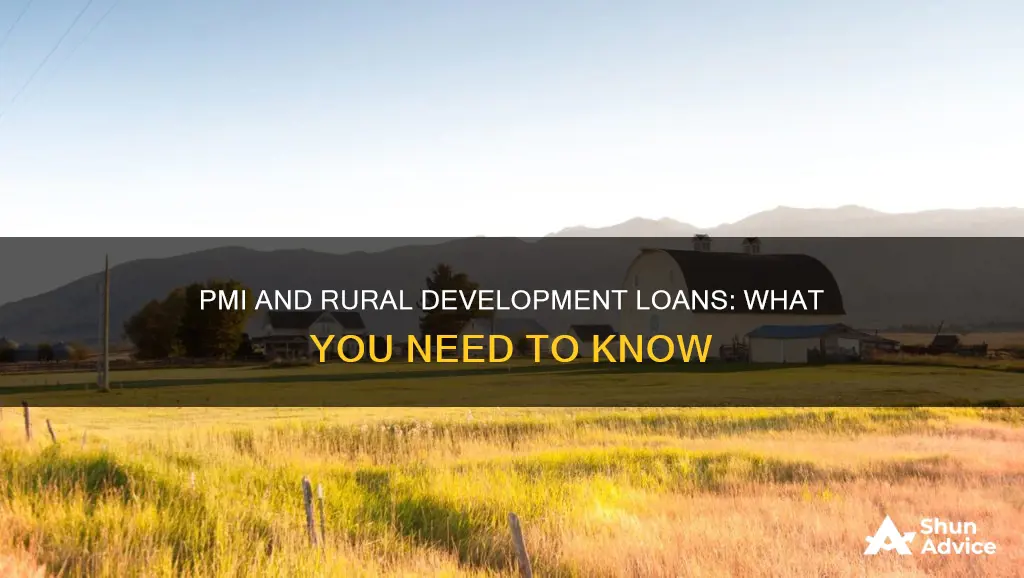
USDA loans, also known as rural development loans, are mortgages backed by the U.S. Department of Agriculture. They are designed to promote and increase homeownership in rural areas. These loans do not require private mortgage insurance (PMI), which is typically necessary for conventional loans with a down payment of less than 20%. Instead, USDA loans have an upfront guarantee fee of 1% of the financed amount and an annual fee of 0.35% of the loan balance, paid monthly for the life of the loan.
Rural Development Loans (USDA Loans) Characteristics and Values Table
| Characteristics | Values |
|---|---|
| Down Payment | Zero down payment |
| Credit Score | Minimum of 640 |
| Mortgage Insurance | No PMI, but an upfront guarantee fee of 1% of the financed amount and an annual fee of 0.35% of the loan balance paid monthly |
| Interest Rates | Competitive |
| Property Location | Eligible rural areas as defined by the USDA |
| Income Requirements | Low-to-average household income |
| Debt-to-Income Ratio | Typically capped at 41% |
| Safety and Size Requirements | Property must meet USDA safety and size standards |
What You'll Learn

USDA loans do not require PMI
USDA loans, also known as rural development loans, are mortgages backed by the U.S. Department of Agriculture. These loans are designed to promote and increase homeownership in rural areas outside of metropolitan populations.
The absence of PMI on USDA loans is a significant advantage for borrowers, as PMI can increase the overall cost of a mortgage. PMI is typically required on conventional loans when the down payment is less than 20%. By contrast, USDA loans offer the possibility of a zero-down payment, making them more accessible to individuals with limited financial resources.
While USDA loans do not have PMI, they still provide protection for lenders through the upfront guarantee and annual fees. These fees serve as a form of mortgage insurance, ensuring that the lender is protected in the event of default. As a result, USDA loans offer a more affordable option for borrowers while still mitigating risk for lenders.
Prosper Loan: Will They Call You Back?
You may want to see also

USDA loans require an annual fee
USDA loans, also known as rural development loans, are government-backed mortgage programs that promote and increase homeownership in rural and semi-rural areas outside of metropolitan populations. Unlike conventional loans, USDA loans do not require private mortgage insurance (PMI) or monthly "PMI" mortgage insurance. Instead, the USDA refers to this as an "annual fee" or "guarantee fee", which is paid monthly for the life of the loan.
The annual fee for a USDA loan is typically 0.35% of the loan's current balance, although this may vary based on the loan program. For example, for a $150,000 loan, the annual fee would be $525, resulting in a monthly payment of $43.75. This fee is less when compared to FHA loans, which have a fee factor of 0.55% of the loan amount.
It is important to note that USDA loans do have an upfront guarantee fee, in addition to the annual fee. The upfront fee is typically 1% of the financed amount, paid at closing. For a $150,000 loan, this would amount to a $1,500 upfront guarantee fee, resulting in a final loan amount of $151,500. This upfront fee is separate from the annual fee and is a one-time cost associated with the USDA loan.
The annual fee for a USDA loan is similar to the PMI required for conventional loans when a down payment of less than 20% is made. However, for conventional loans, PMI can be removed once the mortgage balance reaches 80% or less of the home's value. On the other hand, the annual fee for a USDA loan is paid for the life of the loan and cannot be removed.
Refinancing: Loan Length, Change and What You Should Know
You may want to see also

USDA loans require an upfront guarantee fee
USDA loans, also known as rural development loans, are backed by the United States Department of Agriculture to promote and increase homeownership in less-populated areas outside of metropolitan centres. These loans do not require a down payment, making them an appealing option for borrowers.
While USDA loans do not require monthly private mortgage insurance (PMI), they do have an upfront guarantee fee of 1% of the financed amount, paid at closing. This fee is similar to the PMI required for conventional loans with a down payment of less than 20%. However, for USDA loans, instead of PMI, there is an "annual fee" paid monthly for the life of the loan. This annual fee is 0.35% of the loan's current balance and is less expensive compared to the monthly PMI for FHA loans.
The upfront guarantee fee for USDA loans is a one-time cost that helps to protect the lender in case of default. It is important to note that this fee is separate from the interest rate on the loan and is typically not refundable. By paying this fee, borrowers may be able to obtain a lower interest rate on their USDA loan, depending on their financial situation and credit history.
The upfront guarantee fee for USDA loans is typically rolled into the loan amount and paid at closing. This means that borrowers do not need to bring additional funds to the closing table. However, it is essential to consider this fee when calculating the total cost of the loan. Borrowers should also be aware that, in addition to the upfront fee, there may be other costs associated with the loan, such as closing costs and annual fees.
Overall, while USDA loans do require an upfront guarantee fee, they can still be a more affordable option compared to other loan types that require a down payment and PMI. It is always recommended to consult with a loan officer or financial advisor to determine the best loan option based on individual circumstances.
Rent-A-Center Cash Loans: What You Need to Know
You may want to see also

USDA loans are only for eligible rural areas
USDA loans are backed by the United States Department of Agriculture to promote and increase homeownership in areas outside of metropolitan populations. These loans are only for eligible rural areas, and there are specific criteria that define a property's USDA eligibility.
Firstly, the property must be located in a "rural" part of the country, as defined by the USDA. The USDA's definition of "rural" is based on a community's population, its proximity to a major metropolitan statistical area (MSA), and overall access to mortgage credit in the area. For instance, an area with no more than 10,000 residents is considered rural. If the area has between 10,001 and 20,000 residents, it cannot be located in an MSA to qualify as rural. Additionally, there should be a lack of mortgage credit available for low- and moderate-income families in the area.
Secondly, to determine eligibility, you can use the USDA's Eligibility Site or refer to a USDA eligibility map. The map will show you the eligible rural areas, and you can also enter a specific address to verify its eligibility. These maps are available online and can be found on the USDA's website or through resources like Neighbors Bank.
It's important to note that while these loans are referred to as rural housing loans, you don't necessarily have to live in the countryside or purchase farmland. In fact, a significant portion of the country is eligible for these loans, and many people living in towns and smaller cities may qualify.
To summarize, USDA loans are specifically designed to support homeownership in eligible rural areas. By considering factors like population size, proximity to metropolitan areas, and access to mortgage credit, the USDA ensures that its loans are directed towards communities that need this financial assistance to thrive and improve their quality of life.
Refinancing: A Fresh Start or Loan Reset?
You may want to see also

USDA loans have more flexible credit score requirements
USDA loans are unique in that they do not have a set minimum credit score requirement. This is because the USDA does not directly lend the money; instead, they insure loans made by approved lenders. This means that the specific credit score you need for a USDA loan will depend on the individual lender's requirements. Typically, a credit score of 620 or 640 is considered the minimum for a USDA loan. However, it is important to note that some lenders may be willing to manually underwrite loans for borrowers with lower credit scores, especially if they have other factors that reduce their risk, such as a low debt-to-income ratio or substantial savings.
The flexibility of USDA loans when it comes to credit scores is a significant advantage for borrowers who may not qualify for other types of loans. This is because credit scores are a critical factor in the loan approval process, as they indicate an individual's financial habits and responsibility. A higher credit score suggests that a borrower is more likely to make on-time bill payments and manage their finances effectively. On the other hand, a lower credit score can indicate a higher risk for the lender, as it suggests that the borrower may be less responsible with credit.
While USDA loans offer more flexibility in terms of credit score requirements, it is important to note that they also have other eligibility criteria. For example, USDA loans are designed for low-to-moderate-income homebuyers and are only available for properties located in specific rural or suburban areas. Additionally, borrowers must demonstrate a strong track record of paying their monthly obligations and meet certain income and asset requirements.
Despite the flexibility in credit score requirements, it is always advisable for borrowers to work on improving their credit scores before applying for any type of loan, including USDA loans. This can be achieved by paying down debts, increasing available credit, and regularly reviewing credit reports for any errors. By taking proactive steps to enhance their creditworthiness, borrowers can increase their chances of loan approval and secure more favourable loan terms.
Robinhood's Loan Offerings: What You Need to Know
You may want to see also
Frequently asked questions
Rural development loans, also known as USDA loans, do not require PMI. However, they do require an upfront guarantee fee of 1% of the financed amount, paid at closing, and an annual fee of 0.35% of the loan balance, paid monthly for the life of the loan.
PMI stands for private mortgage insurance. It is designed to protect lenders in case the borrower defaults on their loan. It is typically required for conventional loans when the down payment is less than 20%.
Rural development loans offer several benefits, including zero down payment requirements, competitive interest rates, and reduced mortgage insurance costs. They are designed to promote homeownership in rural areas and are available to individuals with low-to-average household incomes.







